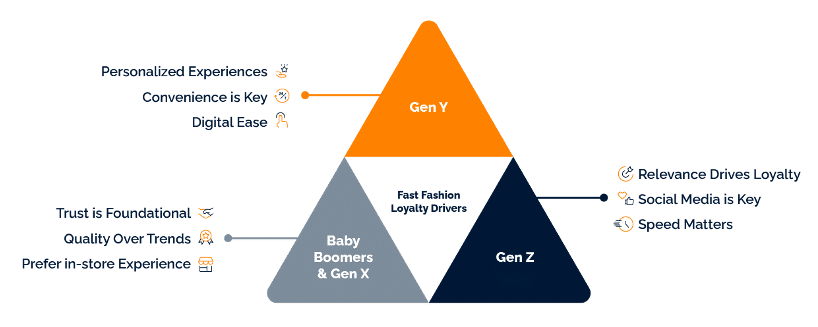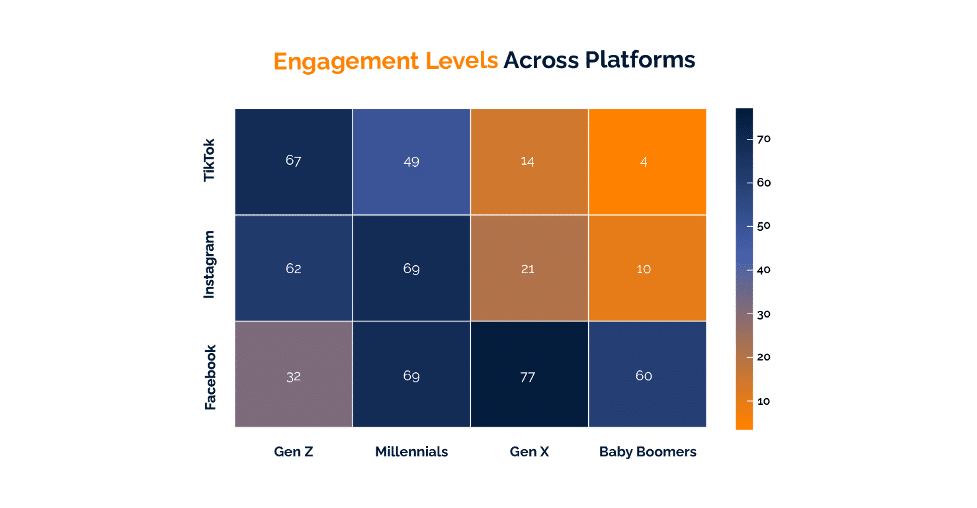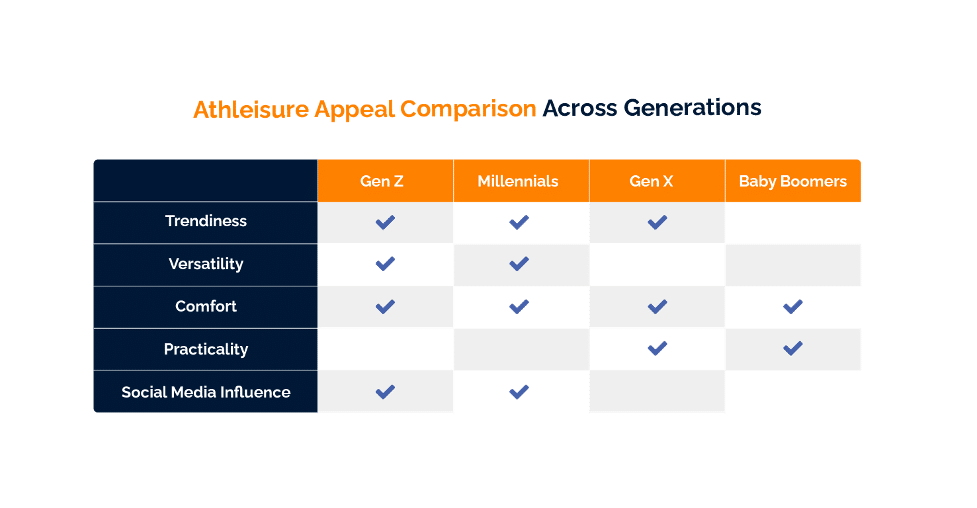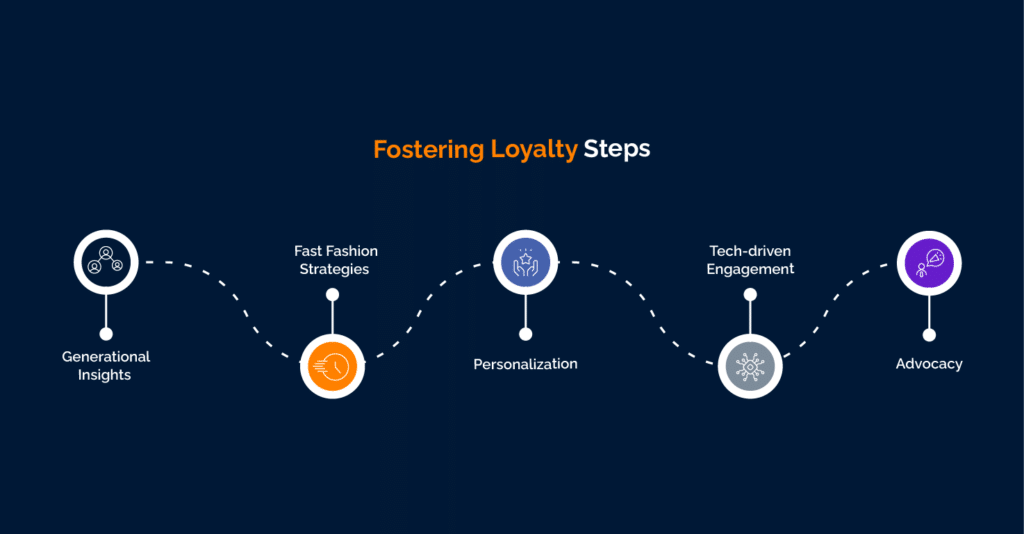How Fast Fashion Brands Are Building Unbreakable Consumer Connections
In an industry driven by trends that change in the blink of an eye, loyalty often feels like a fleeting dream for fashion brands. But here’s the twist: today’s consumers aren’t just chasing the next big look—they’re searching for brands that get them. They want value, speed, and authenticity, all wrapped in a seamless shopping experience.
For brand executives, this presents both a challenge and an opportunity. The key lies in decoding consumer behaviors, desires, and even contradictions to deliver what they crave—without compromising your identity or margins. Our comprehensive research revealed critical insights for helping brands build consumer trust, foster loyalty, and transform shoppers into advocates.
In a fast-moving industry where trust and connection define success, standing out requires a deep understanding of the trends and loyalty drivers that truly resonate with today’s consumers.
The Fashion Loyalty Dilemma: Standing Out in a Fast-Paced Market
Building and retaining trust and loyalty in an industry so rooted in change is no small feat. Today’s shoppers, particularly Gen Z and Millennials, are savvy, impatient, and unafraid to switch allegiances for a better deal, a trendier product, or a brand they feel aligns more closely with their values.
According to our research, 56% of consumers cite better discounts as a primary reason for switching brands, while 58% prioritize product quality above all else. Clearly, loyalty isn’t just about making consumers happy—it’s about keeping them from looking elsewhere.
The challenges don’t stop there. Fast fashion brands are under growing pressure to adopt sustainable manufacturing practices, balancing environmental responsibility with the demand for affordability. While luxury consumers increasingly expect sustainability and are willing to pay a premium for it, fast fashion shoppers remain price-sensitive, prioritizing cost and convenience over eco-conscious choices.
So, how do brands crack the loyalty code? It starts with understanding exactly what modern shoppers value most.
Cracking the Code: Loyalty Drivers Across Generations
Generational Priorities: Trust, Speed, and Trends
For Gen Z, loyalty is built on immediacy. Platforms like TikTok and Instagram aren’t just spaces for discovery—they’re integral to their shopping journey. This group is far more likely to find brands through social media pages and word-of-mouth than traditional ads. They value relevance, with loyalty often tied to a brand’s ability to quickly align with their constantly evolving preferences.
Millennials (Gen Y) share Gen Z’s love for trends but look for added convenience. Seamless shopping experiences like click-and-collect services and personalized content play a critical role in capturing their loyalty.
In contrast, Baby Boomers and Gen X are more traditional. Their loyalty stems from trust and reliability, with in-store experiences where they can see and feel products continuing to dominate their preferences. Consistent quality and perceived value outweigh fleeting trends for these groups.
These generational differences highlight a shared expectation among shoppers: value, convenience, and relevance. Fast fashion has become a dominant force in the industry by meeting these demands head-on, reshaping the landscape with its ability to deliver trends at breakneck speed and accessible prices.

Fast Fashion: Fueling the Desire for Speed
Fast fashion dominates 88% of the American clothing industry and thrives due to its ability to deliver what modern shoppers want most: affordability, immediacy, and a steady stream of trend-driven styles. For Gen Z and Millennials, these qualities align perfectly with their preference for staying on-trend without overspending.
Brands like SHEIN have mastered this model by combining massive product ranges with rock-bottom pricing and influencer-driven promotion. For these younger consumers, who prioritize speed and accessibility, fast fashion is a natural fit for their buying habits. The result is a cycle of constant demand, fueled by speed, the allure of always having something new, and social media platforms that turn viral trends into must-have items virtually overnight.

The Role of Social Media in Driving Loyalty
Like many consumer product categories, social media platforms like TikTok and Instagram play a pivotal role in shaping loyalty in high street fashion. For Gen Z, these platforms are more than just discovery tools—they’re spaces where brands can build ongoing relationships. Viral trends and influencer endorsements act as gateways to brand loyalty, creating instant connections that evolve into long-term trust.
By serving as both discovery channels and loyalty touchpoints, social media allows brands to be part of the consumer’s everyday life, making it easier to sustain relevance.

Athleisure: Comfort as a Cross-Generational Trend
If there’s one category that unites consumers across generations, it’s athleisure. With its focus on comfort, versatility, and practicality, athleisure reflects a growing demand for clothing that fits seamlessly into diverse lifestyles.
For Gen Z, athleisure blends functionality with everyday fashion, while Baby Boomers appreciate its practicality for active lifestyles. Millennials and Gen X value its versatility, embracing it for work-from-home days, errands, and casual outings. By delivering stylish yet adaptable options, athleisure has become a loyalty driver that resonates with consumers regardless of age.
Athleisure shows how brands can resonate by catering to broad lifestyle needs, but today’s consumers want more than functional products. They expect brands to recognize their individuality and create shopping experiences that feel uniquely tailored—an expectation increasingly driven by technology.

Personalization and Technology: Elevating the Consumer Experience
In a world brimming with choices, personalization has become the ultimate loyalty driver. Shoppers—especially Gen Z and Millennials—crave experiences that feel custom-fit to their tastes. These generations don’t just want to shop; they want to feel understood. Younger consumers are open to sharing their data, as long as it results in curated recommendations or exclusive perks that enhance their journey.
Technology lies at the heart of this transformation. Artificial intelligence and machine learning are turning vast amounts of consumer data into meaningful insights, enabling brands to create personalized recommendations that feel effortless yet remarkably precise. A well-timed email showcasing a shopper’s favorite styles, an app that remembers their sizing preferences, or a dynamic homepage featuring complementary items can turn casual browsing into memorable interactions.
While younger shoppers embrace this level of tech-powered engagement, Baby Boomers and Gen X bring a different set of expectations. These groups value personalization when it feels trustworthy and unobtrusive. For them, privacy and reliability are non-negotiable, emphasizing the need for brands to balance tailored experiences with transparency.
Beyond personalization, technology is also transforming the systems that power these experiences. Tools like predictive inventory management, automated supply chains, and data-driven marketing strategies ensure that the personalized offers shoppers receive are backed by operational precision.
This alignment between front-end personalization and back-end efficiency creates a seamless experience where shoppers feel seen and valued while brands deliver on their promises.
At its core, personalization isn’t just about recommending products—it’s about fostering trust through consistency, relevance, and flawless execution.
Driving Loyalty and Success in High Street Fashion
Securing Loyalty in high street fashion requires more than trendy products or competitive pricing. It requires forging meaningful connections with consumers. By understanding generational preferences, leveraging social media’s power, and embracing technology-driven personalization, brands can create experiences that turn casual shoppers into devoted customers.
Achieving this level of engagement takes precision. It means delivering the right message at the right time and aligning with what truly matters to your audience. Whether it’s tailoring your approach for Gen Z’s digital-first habits, using AI to craft personalized recommendations, or tapping into fast fashion’s speed to stay relevant, success hinges on how well you adapt to a rapidly evolving landscape.
That’s where Theorem comes in. As a partner dedicated to helping fast fashion brands thrive, we specialize in harnessing data-driven insights to deliver personalized content strategies, cutting-edge MarTech solutions and optimized e-commerce experiences. Let us help you turn today’s challenges into opportunities for long-term growth.

Take the next step. Partner with Theorem to build deeper connections, inspire loyalty, and shape the future of high street fashion. Contact us today to get started.








